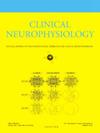非侵入性运动皮层和脊髓刺激在慢性颈脊髓损伤中的时间依赖性协同作用。
IF 3.6
3区 医学
Q1 CLINICAL NEUROLOGY
引用次数: 0
摘要
目的:脊髓感觉网络与下行运动回路有强烈的相互作用。我们通过配对运动皮质刺激和协调的颈脊髓刺激来瞄准这种相互作用。通过单独的非侵入性和硬膜外实验,我们验证了当成对的脑和脊髓刺激同时在脊髓内汇聚时,最强的肌肉反应会发生的假设。方法:在非侵入性实验中,我们测量了经颅磁刺激(TMS)和经皮脊髓刺激(TSCS)的运动诱发电位。我们比较了这种无创入路和术中使用背侧硬膜外电极对颈椎病患者进行配对刺激实验。结果:在16例慢性脊髓损伤患者和15例未损伤患者中,当阈下TSCS刺激在脊髓内同步收敛时,阈上TMS增强了靶肌反应(11.0%)。诱导与TSCS强度相关。促进作用与脊髓损伤水平或严重程度无关,表明备用回路足以达到这种效果。与术中(硬膜外)配对相比,无创配对产生较少的促进作用。结论:在脊髓损伤患者和非脊髓损伤患者中,感觉运动相互作用可以通过配对刺激进行靶向治疗。意义:适当的时间配对刺激可增强脊髓损伤后的突触反应性。本文章由计算机程序翻译,如有差异,请以英文原文为准。
Timing-dependent synergies between noninvasive motor cortex and spinal cord stimulation in chronic cervical spinal cord injury
Objective
Spinal cord sensory networks strongly interact with descending motor circuits. We targeted this interaction by pairing motor cortex stimulation with coordinated cervical spinal cord stimulation. Using separate non-invasive and epidural experiments, we tested the hypothesis that the strongest muscle response would occur when paired brain and spinal cord stimuli simultaneously converge within the spinal cord. Methods: For non-invasive experiments, we measured motor evoked potentials in response to transcranial magnetic stimulation (TMS) and transcutaneous spinal cord stimulation (TSCS). We compared this noninvasive approach to intraoperative paired stimulation experiments using dorsal epidural electrodes in individuals undergoing surgery for cervical myelopathy. Results: In 16 individuals with chronic spinal cord injury (SCI) and 15 uninjured individuals, suprathreshold TMS augmented target muscle responses (11.0%) when subthreshold TSCS stimuli converged synchronously in the spinal cord. Facilitation correlated with TSCS intensity. Facilitation did not correlate with SCI level or severity, indicating spared circuits were sufficient for this effect. Noninvasive pairing produced less facilitation compared to intraoperative (epidural) pairing. Conclusions: Sensorimotor interactions in the cervical spinal cord can be targeted with paired stimulation in individuals with and without SCI. Significance: Properly timed paired stimulation may enhance synaptic responsiveness after SCI.
求助全文
通过发布文献求助,成功后即可免费获取论文全文。
去求助
来源期刊

Clinical Neurophysiology
医学-临床神经学
CiteScore
8.70
自引率
6.40%
发文量
932
审稿时长
59 days
期刊介绍:
As of January 1999, The journal Electroencephalography and Clinical Neurophysiology, and its two sections Electromyography and Motor Control and Evoked Potentials have amalgamated to become this journal - Clinical Neurophysiology.
Clinical Neurophysiology is the official journal of the International Federation of Clinical Neurophysiology, the Brazilian Society of Clinical Neurophysiology, the Czech Society of Clinical Neurophysiology, the Italian Clinical Neurophysiology Society and the International Society of Intraoperative Neurophysiology.The journal is dedicated to fostering research and disseminating information on all aspects of both normal and abnormal functioning of the nervous system. The key aim of the publication is to disseminate scholarly reports on the pathophysiology underlying diseases of the central and peripheral nervous system of human patients. Clinical trials that use neurophysiological measures to document change are encouraged, as are manuscripts reporting data on integrated neuroimaging of central nervous function including, but not limited to, functional MRI, MEG, EEG, PET and other neuroimaging modalities.
 求助内容:
求助内容: 应助结果提醒方式:
应助结果提醒方式:


